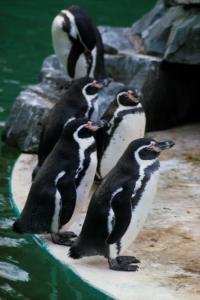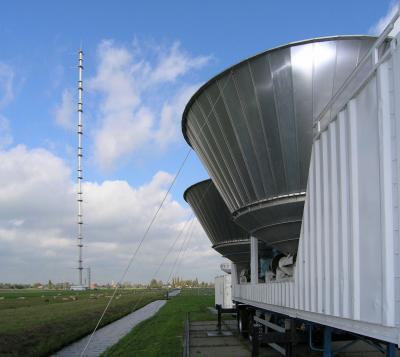On the eve of World Oceans Day, a group of over 100 scientists from 15 countries has revealed new evidence for the declining state of Europe's 4 regional seas
Earth
The global warming debate has focused on carbon dioxide emissions, but scientists at UC Irvine have determined that a lesser-known mechanism -- dirty snow -- can explain one-third or more of the Arctic warming primarily attributed to greenhouse gases.
Sargassum seaweed, famous in nautical lore for entangling ships in its dense floating vegetation, has been detected from space for the first time thanks to an instrument aboard ESA’s environmental satellite, Envisat. The ability to monitor Sargassum globally will allow researchers to understand better the primary productivity of the ocean and better predict climate change. CLICK ABOVE FOR FULL SIZE.
CLICK ABOVE FOR FULL SIZE.
In 1976 a research cruise in the Gulf of Alaska recorded the sighting of "brown penguins."
How was it that birds that swim rather than fly and live almost exclusively in the Southern Hemisphere turned up deep in the Northern Hemisphere? Did they migrate more than 5,000 miles from Peru? Humboldt penguins are native to the Southern Hemisphere, but North America was home to these Humboldts when they lived at Stanley Park in Vancouver, B.C. Credit: Dee Boersma
Humboldt penguins are native to the Southern Hemisphere, but North America was home to these Humboldts when they lived at Stanley Park in Vancouver, B.C. Credit: Dee Boersma
Weather models are not good at predicting rain. Particularly in hilly terrain, this can lead to great damage arising from late warnings of floods, or even none at all. From June 1 to September 1, 2007 Delft University of Technology is participating in a major international experiment in Germany’s Black Forest, to learn more about what causes rain. Aircraft and an airship are to be used alongside ground-based observatories and satellites. TARA at its homebase in Cabauw, Holland. Credit: TU Delft
TARA at its homebase in Cabauw, Holland. Credit: TU Delft
Radical steps to engineer Earth’s climate by blocking sunlight could drastically cool the planet, but could just as easily worsen the situation if these projects fail or are suddenly halted, according to a new computer modeling study.
Discarded crab and lobster shells may be the key to prolonging the life of microbial fuel cells that power sensors beneath the sea, according to a team of Penn State researchers.
To produce energy, microbial fuel cells need organic material for the microbes to consume. However, deep sea sediments can be surprisingly devoid of organic material because living things in the photic zone – the area where light penetrates the water – are continuously recycled and little falls to the ocean floor. An absence of organics limits the lifetime of marine microbial fuel cells.
Southeastern Brazil, South America’s largest and most populous country, is highlighted in this 26 May 2007 Envisat image.
Brazil consists of one federal district and twenty-six states, four of which comprise the southeastern region – Rio de Janeiro, Minas Gerais, Sao Paolo (all visible) and Espirito Santo. CLICK ABOVE FOR HIGH RES. Credits: ESA
CLICK ABOVE FOR HIGH RES. Credits: ESA
The huge potential of agricultural soils to reduce greenhouse gases and increase production at the same time has been reinforced by new research findings at NSW Department of Primary Industries' (DPI) Wollongbar Agricultural Institute.
Trials of agrichar - a product hailed as a saviour of Australia's carbon-depleted soils and the environment - have doubled and, in one case, tripled crop growth when applied at the rate of 10 tonnes per hectare.
New charcoal and plant microfossil evidence from Mexico’s Central Balsas valley links a pivotal cultural shift, crop domestication in the New World, to local and regional environmental history. Agriculture in the Balsas valley originated and diversified during the warm, wet, postglacial period following the much cooler and drier climate in the final phases of the last ice age.
Designing the first fuel-cell manned intercity aircraft is the goal of a recently launched EU-funded project.
The Environmentally Friendly Inter City Aircraft powered by Fuel Cells (ENFICA-FC) project is receiving €2.9 million from the EU as part of the aeronautics and space priority of the Sixth Framework Programme (FP6).
The Polytechnic of Turin is leading the project, the goal of which is to develop an intercity aircraft that uses fuel cell technology for the propulsion system, and hydrogen storage.
Monsoons, the life-giving, torrential rains of Asia and Africa, have an ancient, unsuspected connection to previous Ice Age climate cycles, according to scientists at the University of California, Santa Barbara, and at Kiel University in Germany.
Huge waves that struck Reunion Island and coastlines across Indonesia earlier this month all originated from the same storm that occurred south of Cape Town, South Africa, and were tracked across the entire Indian Ocean for some 10 000 kilometres over a nine-day period by ESA's Envisat satellite. Picture taken on 14 May 2007 in Saint-Leu, on the French Indian Ocean island of Reunion, of a giant wave breaking on t
Picture taken on 14 May 2007 in Saint-Leu, on the French Indian Ocean island of Reunion, of a giant wave breaking on t
The signature of climate change over the past 40 years has been identified in temperatures of the Indian Ocean near Australia.
"From ocean measurements and by analysing climate simulations we can see there are changes in features of the ocean that cannot be explained by natural variability," said CSIRO oceanographer Dr Gael Alory.
"These oceanic changes are almost certainly linked to changes in the heat structure of the atmosphere and have led to a rise in water temperatures in the sub-tropical Indian Ocean of around two degrees celsius.
In 2006, Greenland experienced more days of melting snow and at higher altitudes than average over the past 18 years, according to a new NASA-funded project using satellite observations.